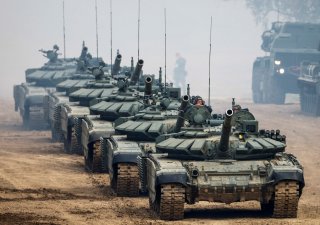Russia Still Worries about a NATO Invasion, and Here’s Why
While the idea of NATO attacking Russia may seem farfetched to most Americans, the Russians have reason to fear an invasion from the west.
Here's What You Need to Remember: Following the end of the Cold War and the dissolution of the Soviet Union, Russia is arguably more vulnerable while many of its former communist-era satellite states – including Poland, Hungary and Romania, along with the Czech and Slovak Republics – now being members of NATO.
Russian state media has reported that the guard tank army of Russia's Western Military District has been reinforced to protect the country's western strategic border. Last month, Minister of Defense Sergei Shoigu told Tass that the western strategic direction remains under the highest threat for Russia's military security, adding that, in accordance with the 2019-2025 plan of action, Russia will conduct a complex series of measures to neutralize the potential threats.
"The Separate Guards Motorized Rifle Sevastopol Red Banner Brigade named after the 60th anniversary of the USSR was included in the Guards Red Banner Tank Army of the Western Military District to perform tasks on ensuring the defense of the Russian Federation in the Western strategic direction," the district’s press service said. "It is armed with modern weapons and military and specialized vehicles, such as T-90A tanks, BTR-82A armored carriers, BMP-3 combat vehicles, and 9A34 Strela-10 and 2S6M Tunguska air defense systems."
In addition, the motorized brigade has been deployed in the Novomoskovsky Administrative District of Moscow.
Earlier this month, head of the Main Directorate of the Russian Armed Forces' General Staff Sergei Rudskoi declared that the Russian Ministry of Defense consistently registered high level of military activity of the U.S. and its NATO allies near Russian borders. He added that the alliance had ramped up its exercises that bear a "distinct anti-Russian character."
While the idea of NATO attacking Russia may seem farfetched to most Americans, the Russians have reason to fear an invasion from the west. Over the past several centuries Russia has been repeatedly invaded by such powers as Poland, Sweden, France and Germany.
The United States also took part in what could be seen as an "invasion" of sorts when troops were sent to Russia during the nation's Civil War in 1918. The American military intervention at Archangel, Russia earning the nickname "Polar Bear Expedition" and it was actually to prevent the German advance and to help reopen the Eastern Front following Communist Russia's acceptance of the Treaty of Brest-Litovsk. Instead of fighting the Germans however, the American soldiers found themselves fighting Bolshevik forces.
Just two decades later Nazi Germany invaded the Soviet Union and drove deep into "Mother Russia," besieging Leningrad and reaching the gates of Moscow before winter set in and stopped the advance. Other Russian cities were occupied and by war's end many had been leveled – including Stalingrad, which had been the site of the mother-of-all battles and the turning point for the Germans.
Following the end of the Cold War and the dissolution of the Soviet Union, Russia is arguably more vulnerable while many of its former communist-era satellite states – including Poland, Hungary and Romania, along with the Czech and Slovak Republics – now being members of NATO.
Thus, it is not surprising that the Russian bear would be sharpening its claws – by upgrading its naval fleets and conducting regular military drills and exercises, while also developing new hardware such as with its T-14 Armata tank and its hypersonic undersea missiles.
Such military hardware could be seen not for their offensive capabilities, but rather as deterrents to ensure that Russia not face yet another invasion from the west.
Peter Suciu is a Michigan-based writer who has contributed to more than four dozen magazines, newspapers and websites. He is the author of several books on military headgear including A Gallery of Military Headdress, which is available on Amazon.com.
This article is being republished due to reader interest.
Image: Reuters.

